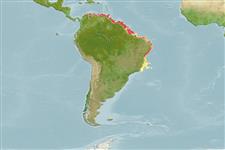Classification / Names
Common names | Synonyms | Catalog of Fishes (gen., sp.) | ITIS | CoL | WoRMS | Cloffa
Actinopterygii (ray-finned fishes) >
Siluriformes (Catfish) >
Ariidae (Sea catfishes) > Ariinae
Environment / Climate / Range
Ecology
Marine; brackish; demersal; depth range 1 - 20 m (Ref. 5217). Tropical, preferred ?; 12°N - 23°S, 77°W - 34°W
South America: Rivers and estuaries from Gulf of Venezuela to mouth of the Amazon River.
Size / Weight / Age
Maturity: Lm ? range ? - ? cm
Max length : 63.0 cm TL male/unsexed; (Ref. 5217); common length : 40.0 cm TL male/unsexed; (Ref. 5217)
Dorsal
spines
(total): 1. Three pairs of barbels on rostral region, two pairs on lower jaw, one pair on posterior end of maxilla; end of maxilla barbel reaching insertion of pectoral fin; body yellow-brown, whitish ventrally; each fin membrane blackish distally (Ref. 13608).
Found on muddy bottoms of shallow brackish waters; also in marine waters. Reproduction seems to occur between May and June. The female lays down 20-30 eggs having a diameter of 10-12 mm, agglutinated in mucus. The male guards the eggs for 10-12 days until hatching (Ref. 35381). Marketed fresh.
Life cycle and mating behavior
Maturity | Reproduction | Spawning | Eggs | Fecundity | Larvae
Taylor, W.R. and N.A. Menezes, 1978. Ariidae. In W. Fischer (ed.) FAO species identification sheets for fishery purposes. West Atlantic (Fishing Area 31). volume 1. [pag. var.]. FAO, Rome. (Ref. 3265)
IUCN Red List Status (Ref. 115185)
CITES (Ref. 94142)
Not Evaluated
Threat to humans
Traumatogenic (Ref. 58010)
Human uses
Fisheries: minor commercial
More information
Common namesSynonymsMetabolismPredatorsEcotoxicologyReproductionMaturitySpawningFecundityEggsEgg development
ReferencesAquacultureAquaculture profileStrainsGeneticsAllele frequenciesHeritabilityDiseasesProcessingMass conversion
Tools
Special reports
Download XML
Internet sources
